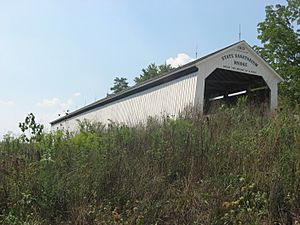Sanitorium Covered Bridge facts for kids
Quick facts for kids State Sanitorium Covered Bridge |
|
|---|---|

Southern Side and Eastern Portal
|
|
| Coordinates | 39°46′52″N 87°8′42″W / 39.78111°N 87.14500°W |
| Carries | C.R. 100N |
| Crosses | Little Raccoon Creek |
| Locale | Parke, Indiana, United States |
| Official name | State Sanitorium Covered Bridge |
| Named for | The State Sanitorium |
| Maintained by | Parke County |
| NBI Number | 6100240 |
| Characteristics | |
| Design | National Register of Historic Places |
| Total length | 170 ft (52 m)154ft +8ft overhangs on each end |
| Width | 16 ft (4.9 m) |
| Height | 12.5 ft (3.8 m) |
| History | |
| Constructed by | Britton, J.A. |
| Rebuilt | 2008 |
| MPS | Parke County Covered Bridges TR |
| NRHP reference No. | 78000412 |
| Added to NRHP | Dec 22, 1978 |
| Lua error in Module:Location_map at line 420: attempt to index field 'wikibase' (a nil value). | |
The Sanitorium Covered Bridge is a special kind of bridge found east of Rockville, Indiana. It's a covered bridge, meaning it has walls and a roof, like a long tunnel. This bridge uses a unique design called a Burr Arch, which helps make it strong. A skilled builder named Joseph A. Britton built it in 1913. Because it's so important and historic, it was added to the National Register of Historic Places in 1978.
Contents
The Bridge's Early Days
Building a Hospital Bridge
In 1907, the Indiana government decided to build a State Tuberculosis Hospital. This hospital, also called a Sanitorium, was for people who were sick with tuberculosis. By 1908, they had picked a spot for it east of Rockville. The Sanitorium opened its doors in 1910.
Why the Bridge Was Needed
The Sanitorium needed a lot of coal to keep warm and to power its machines. This coal came from mines near Nyesville, which was only a few miles away. The Sanitorium Covered Bridge was first built in 1913 to help transport this coal. It was located on the hospital's land, a little downstream from where it is today. Before this bridge, coal was likely hauled over another bridge called the Plank Road Bridge. However, that bridge was washed away in a big flood in 1913.
A Bridge on the Move
From Private Land to Public Use
After the State Sanitorium was sold, the bridge was on private property. It started to get old and worn out. To save this historic bridge, a big project began on July 30, 2008. The plan was to move the bridge to a new spot. This new location was where another bridge, the Adams Covered Bridge, used to be. The Adams Bridge had been destroyed by a flood in 1969.
Surviving Floods and Finding a New Home
Interestingly, the Adams Bridge had washed downstream and even went under the Sanitorium Bridge during that 1969 flood! Later, in 1970, the Jessup Covered Bridge was moved to replace the Adams Bridge. But in 1989, another flood hit. This time, the Jessup Bridge also washed downstream, going under the Sanitorium Bridge and over the U.S. 36 bridge.
The project to move the Sanitorium Bridge cost about $1.34 million. By December 29, 2008, the bridge was open for traffic at its new location. This move helped save a piece of history and allowed the bridge to be used by everyone again.

